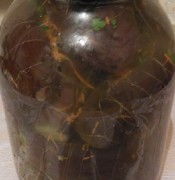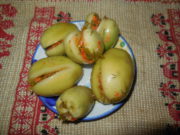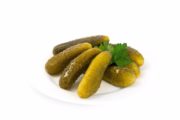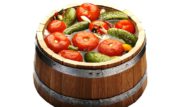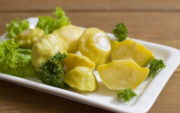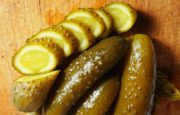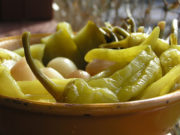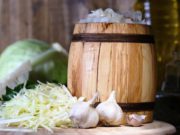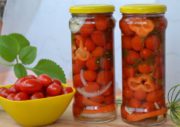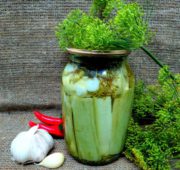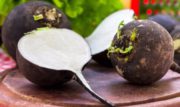Pickling-fermentation
The ancients learned to ferment and salt foods to preserve them for the winter. You can salt everything for future use: fish, meat, mushrooms, watermelons, cucumbers, tomatoes... The most commonly used vegetables for pickling are tomatoes, cabbage, garlic and beets. Snacks preserved in this popular way will decorate the holiday table, delight the family on weekdays, and will be useful for preparing other dishes. The processes of pickling and fermenting are not at all difficult to do at home. In this section you can familiarize yourself with various recipes with photos that will help even novice housewives learn how to salt and ferment foods. How to make such preparations for the winter is described in detail and step by step.
The best recipes with photos
Pickles in jars like in a barrel without sterilization
Previously, crispy pickles were only available to those lucky enough to have their own cellars. After all, cucumbers were salted, or rather fermented, in barrels and stored for the winter in a cool place. Every family had its own secret of pickling, which was passed down from generation to generation. Modern housewives usually have nowhere to store a barrel of cucumbers, and homemade recipes have been lost. But this is not a reason to give up the traditional crunchy cucumber delicacy.
Salted eggplants with carrots and garlic - a step-by-step recipe with photos of spicy stuffed eggplants.
Try preparing salted eggplants with carrots, garlic and a little fresh parsley for the winter using my simple homemade recipe. This easy-to-prepare and delicious eggplant appetizer is a favorite among my household.
Quick pickles
Summer is in full swing and it's time to think about creating delicious homemade preparations for the winter. Pickled cucumbers are one of our favorite winter treats. Today I will tell you how you can make delicious homemade instant pickles.
Salted green tomatoes stuffed with garlic and herbs for the winter
Autumn time has come, the sun is no longer warm and many gardeners have late varieties of tomatoes that have not ripened or remain green at all. Don’t be upset; you can make a lot of delicious winter preparations from unripe tomatoes.
Quick sauerkraut without vinegar - how to cook instant sauerkraut with carrots and apples - recipe with photo.
When my family got tired of sauerkraut prepared according to the classic recipe without additives, I decided to experiment and, when fermenting, added chopped apple slices and grated carrots to the cabbage. It turned out very tasty. The sauerkraut was crispy, the apples gave it some punch, and the carrots had a nice color. I am happy to share my quick recipe.
The last notes
How to pickle cucumbers with vinegar in jars - preparation recipe
Everyone loves pickles. They are added to salads, pickles, or simply crunched, enjoying the spicy spiciness. But for it to have a really pleasant taste, the cucumbers need to be pickled correctly.
How to pickle cucumbers in liter jars so that they are tasty and crispy
Pickles are a universal appetizer for almost any side dish. Spicy, crispy cucumbers are no less tasty than pickled ones, and they can be prepared almost in an assembly line manner. There is no need for sterilization or pasteurization, and storage of pickled cucumbers does not require special conditions.
How to salt cabbage in brine in a jar
Some varieties of cabbage are not distinguished by their juiciness, and winter varieties are even “oaky”. It is impossible to use such cabbage for salads or borscht, but it can be fermented in brine. Typically, such cabbage is fermented in three-liter jars and pickled as needed throughout the year. This type of fermentation is good because it always produces cabbage.
How to salt whole heads of garlic for the winter
Salted garlic, unlike pickled garlic, retains its properties almost like fresh garlic. The only difference is that you can eat it just like that. It is better to salt garlic when it is at medium ripeness and its husk is still soft. Garlic heads, or cloves, are salted using various spices. These spices slightly change the color of the heads and their taste. You can try pickling garlic in different jars according to different recipes, and then get a multi-colored assortment.
A simple recipe: how to pickle tomatoes in a barrel for the winter
Surely everyone has tried barrel tomatoes at least once in their life. If so, you probably remember their sharp-sour taste and incredible aroma. Barrel tomatoes taste significantly different from ordinary ones fermented in a bucket, and we will now look at how to pickle them correctly.
How to salt squash in jars for the winter
Squash belongs to the pumpkin family, like zucchini. The squash has an unusual shape and is a decoration in itself. Large squash are used as baskets for stuffing meat and vegetable dishes. Young squash can be pickled or pickled.
How to pickle cucumbers with dry mustard for the winter
Good housewives love to surprise their loved ones and pamper them with new recipes. Old and time-tested recipes are great, but everything was once new? Discover pickled cucumbers with mustard.
How to pickle oyster mushrooms hot
Oyster mushrooms are one of the few mushrooms that are cultivated and grown on an industrial scale. In terms of nutritional value, oyster mushrooms can be compared to meat and dairy products, and at the same time, they have properties that break down cholesterol.
How to salt Tarkin pepper for the winter
When it comes to national dishes, many take credit for the invention of the recipe. And you can’t argue with them, because sometimes it’s not easy to find the original source. It's the same story with Tarkin pepper.Many have heard this name, but no one knows what “Tarkin pepper” is.
How to salt champignons - two salting methods.
Champignons are one of the few mushrooms that can be eaten raw without heat treatment. The only requirement is that the mushroom is young and fresh. If the mushrooms have been on the supermarket shelf for two weeks, it’s better not to risk it. Moreover, salted champignons are much tastier than fresh ones, and in this case, safer.
How to pickle porcini mushrooms for the winter - three ways
Porcini mushrooms are rightfully considered royal mushrooms. They are incredibly tasty and aromatic, and they retain their aroma in any form. Even an inexperienced mushroom picker will recognize the smell of porcini mushrooms from thousands of them. Such mushrooms can and should be prepared for the winter, and pickling white mushrooms is the oldest recipe of our ancestors.
How to salt cabbage in a barrel for the winter - an old recipe, proven by generations
Sauerkraut has one strange property. It tastes different every time, even if it is made by the same housewife, according to the same recipe. When preparing cabbage for the winter, you never know for sure what it will turn out like. To ensure that the cabbage turns out delicious in any case, you should use old pickling recipes and remember some tricks.
How to salt ferns for the winter - the taiga method of salting
In Asian countries, pickled bamboo is considered a traditional dish.But bamboo does not grow here, but there is a fern that is in no way inferior to bamboo in nutritional value and taste. This was highly appreciated by Japanese chefs, and salted fern has firmly taken its place in Japanese cuisine.
How to salt horseradish - a spicy seasoning for the winter
If someone tells you that jellied meat can be eaten without horseradish, he doesn’t understand anything about Russian cuisine. Horseradish is the best seasoning not only for jellied meat, but also for fish, lard, meat, and we’re not even talking about the benefits of horseradish. Oddly enough, horseradish is used much more often in folk medicine than in cooking, and this needs to be corrected.
How to pickle cherry tomatoes for the winter
Cherry is a variety of small tomatoes that are very convenient to prepare for the winter. Due to their size, they fit very compactly into a jar, and in winter you get tomatoes, not brine or marinade. There are many options for how to pickle cherry tomatoes for the winter.
How to pickle zucchini in jars for the winter
If in winter salted zucchini on the market are almost more expensive than cucumbers, then in summer they are sometimes given away for free. Zucchini is unpretentious and grows under any conditions, even among not very hardworking housewives. They are cheap in the summer, and you should definitely take advantage of this to add a little variety to your pickles for the winter.
Frozen sauerkraut for the winter: the best way to store it in the freezer
Recently, many housewives have given up preparing vegetables for the winter. But this is only because there is nowhere to store all these jars of pickles. There are no cellars anymore, and the storerooms are sometimes too warm.If jars of pickled vegetables are normal, then pickled vegetables become acidic and become inedible. Some pickles can be frozen, and sauerkraut is one of them.
Pickled or pickled onions for the winter - a soft and healthy snack
When fermenting or pickling vegetables, many housewives add small onions to the brine for taste. Just a little, but with onions any dish becomes tastier. Then, opening a jar of pickled cucumbers or tomatoes, we catch these onions and crunch them with pleasure. But why not ferment the onions separately? It's tasty, healthy, and not very troublesome.
Pickled radish: vitamin salad for the winter
Everyone knows that black radish juice is the best cure for bronchitis. But few people eat the radish itself; its taste and smell are too strong. Or maybe you just didn’t know that you can make a delicious salad from radishes and not suffer from this spiciness at all? You just need to ferment the radish and enjoy the piquant, gentle sourness and mild spiciness.
The best assorted recipe: pickled cucumbers with tomatoes
Pickling vegetables for the winter requires having a large amount of containers. There are not always so many barrels or buckets in the house, and you have to choose what exactly to salt. These pangs of choice can be avoided by salting the assortment. Pickled cucumbers and tomatoes sit perfectly next to each other, they are saturated with each other’s taste, and saturate the brine with more interesting notes.


